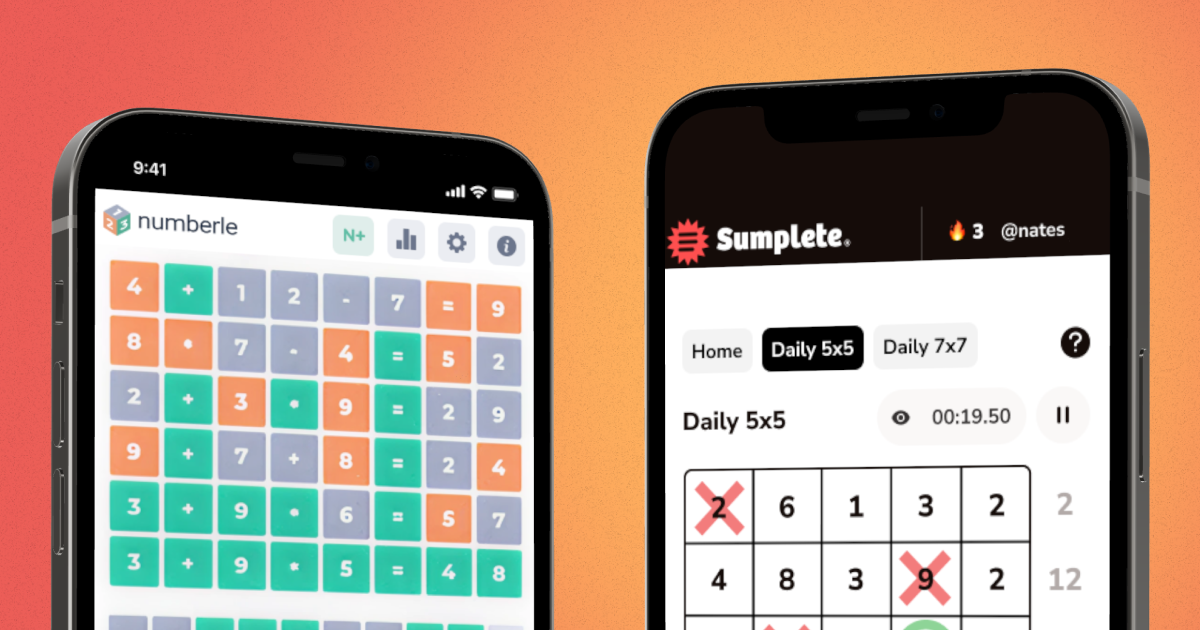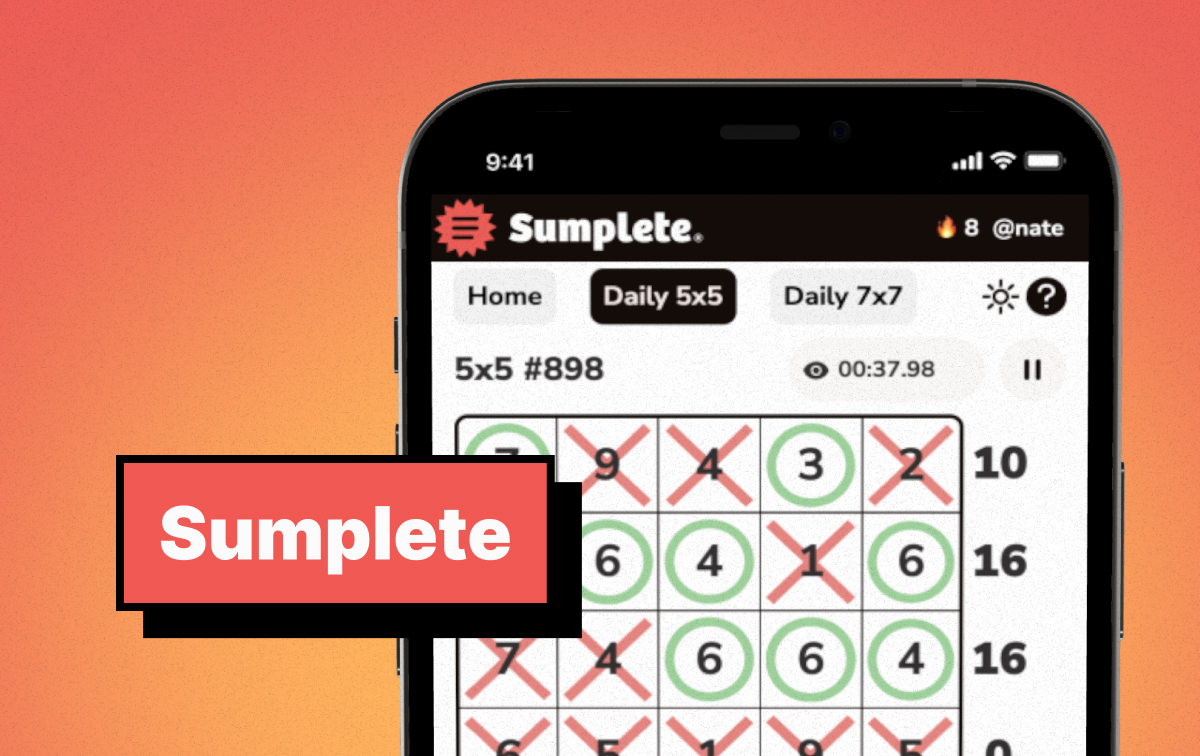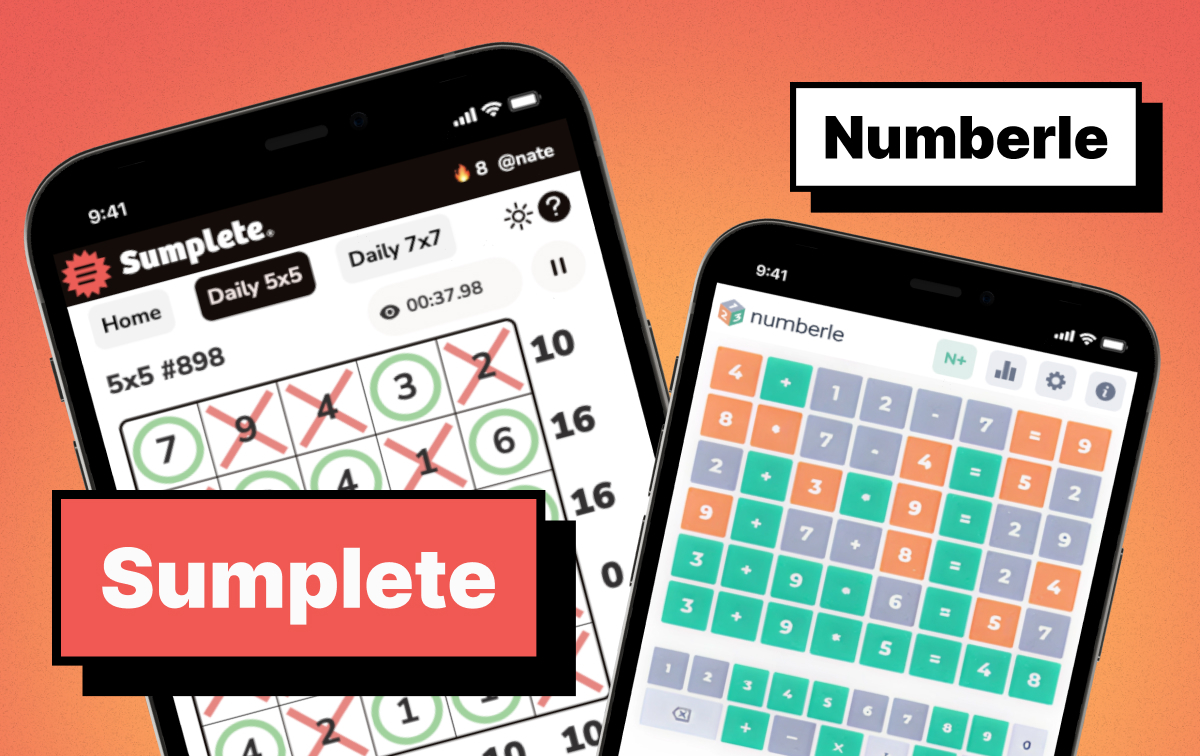Sumplete vs Numberle: Which Math Puzzle Is Smarter?

What Is Numberle?
Numberle is a Wordle-style math puzzle that challenges players to guess the values in an 8-part mathematical equation using digits and operators. Here’s a quick breakdown of how the game works:
An equation like:
9-3+4=10
… serves as a perfect example.
Let’s say that the equation above is the answer to a Numberle puzzle. If a player were to guess:
9-4+3=10
- The “9,” “+,” “=,” “1,” and “0” would appear green. Green cells indicate that the player has guessed the right digit or operation in the correct position in the equation.
- The “3” and “4” would appear yellow. Yellow cells indicate that the player has guessed the right numbers or operations, but they have put them in the wrong cell.
If a player were to guess:
9+4+3=16
- The first “+” and “6” in “16” would appear gray. Gray cells indicate incorrect guesses.
The goal of Numberle is to guess a “valid” equation in six or fewer attempts. Numberle is a favorite among casual math fans and Wordle enthusiasts.
What Is Sumplete?

Sumplete is a logic-based number game in which players must match the sum of the numbers in each row and column to the corresponding “sum clue” for that line. At first, it may seem like a Sumplete puzzle is nothing more than a guessing game. In reality, Sumplete is a logical reasoning number game that requires players to deploy strategies and leverage quick mental math to win. You certainly could choose to guess your way to a Sumplete victory, but it’s not an efficient method by any means. The best Sumplete players use deduction at a rapid pace to determine which numbers need to be eliminated or selected to solve the board.
Beginners can try the 3x3–9x9 easy boards to get a feel for the game before attempting the daily 5x5 or 7x7 boards to compete against players from around the world. There are also more advanced levels for players seeking a real challenge, such as the 7x7 Expert board or the 9x9 Master level.
The average solve time for a game of Sumplete is 3–8 minutes. Think you can beat it?
Play a free Sumplete board now →
Numberle vs Sumplete — two sides of the math puzzle spectrum
| Feature | Numberle | Sumplete |
|---|---|---|
| Core mechanic | Guess hidden equations | Eliminate numbers to hit sum clues |
| Math type | Equations & operations | Addition & subtraction sums |
| Logic vs luck | Moderate (feedback-driven guessing) | High (deductive elimination) |
| Solve time | 1–3 min | 1–8 min |
| Difficulty range | Fixed | Easy → Master (scalable) |
| Mobile UX | Keyboard inputs | Tap/click board with auto-mark |
| Replay value | Limited (static format) | High (daily + practice grids) |
Which Game Builds Better Math Skills?
Both Numberle and Sumplete can help players build better math skills. The truth of the matter is that each game addresses a different focus area of mathematics.
Numberle players can improve their arithmetic fluency as they adjust equations and their order of operations to match the valid answer for each game. Over time, players will find that their equation recognition skills will improve as a result of playing Numberle consistently. Younger players who may be practicing mathematical operations can use Numberle as a fun vehicle to boost their skills.
Sumplete helps players strengthen their logical deduction and sum reasoning skills as they quickly attempt to solve for the sum clues on the board. Sumplete players often find that their spatial pattern recognition skills improve over time as their ability to eliminate and select cell values quickens through repetition.
As mentioned earlier, students can gain great benefits from playing Numberle, such as an enhanced ability to speedily recognize and solve different equations. That said, it can also be fun for the common player just looking to try a game that looks and feels a lot like Wordle.
Adults and logic fans of all ages often gravitate to Sumplete due to the game’s heavy reliance on quick mental reasoning. If you are someone who is drawn to competitive problem-solving games, you will probably find Sumplete enjoyable.
Common Strategies for Each Game
What are some Numberle Tips?
- Always start with balanced equations, or equations that contain a (roughly) even number of varied numerical digits and mathematical operations.
- Use elimination logic based on color feedback. If you see gray cells, you should immediately eliminate those inputs from contention. Green cells should be locked in the moment they appear, and the positions of inputs that appear yellow should be eliminated from your running list of cells where said inputs can be placed.
- Focus on operator placement early. It’s considerably easier to guess which mathematical operations will be included in the final equation (there are five total, with one being the mandatory “=”) than it is to guess which numbers will be present.
What are some Sumplete Tips for faster solves?
- Experienced players will always start by solving for the smallest sum clues before progressing to the larger targets, as smaller sum clues will have fewer viable candidates per line. Once the smaller targets have been hit, gradually work your way up to the larger targets.
- Use intersection logic (otherwise known as crosshair zeroing) to ensure that your eliminations and selections in a given line do not invalidate the intersecting line. In plain English: if a move works one way, but it screws up the line going the other way, don’t make that move!
- Don’t auto-mark a line until you are confident in your residuals. In other words, don’t eliminate the remaining cells in a row or column unless you are sure they won’t be needed to win the game. Auto-marking can be a huge time-saver and a very valuable tool when used correctly, but auto-marking a line incorrectly can be extremely costly.
What are the Levels of Difficulty and Replay Value for Each Game?
Numberle has a fixed difficulty and is limited to 8-part equations. The novelty of the Wordle-like style is a fun twist, but it does tend to fade over time due to the fact that the game doesn’t really get progressively more difficult as you keep playing. You might run into some unique combinations here or there, but you’ll never solve for a 9 or 10-cell equation or run into a truly mathematical operation.
In terms of replay value, Sumplete offers scalable grid sizes and difficulties. Players who get comfortable at the smaller grids and easier difficulty levels can make the jump to harder boards with just a few clicks. Sumplete also features rotating daily puzzles, which help keep competition fresh day after day. Sumplete currently averages roughly 30,000 plays per day across the daily 5x5 and 7x7 grids.
You can make an analogy to running for both games. Numberle is like a mathematical sprint, whereas Sumplete is an endurance logic run.
Which One Should You Play?

Your gameplay preferences and playstyle will help you determine which game you should try. Ultimately, both games are excellent for those interested in improving their math skills!
If you are a casual puzzle player looking to play a few quick games, Numberle is a good choice. It requires a solid understanding of mathematical operations, and the Wordle-inspired style can make for a fun guessing game. But be warned — you won’t be able to rely solely on math to solve a Numberle board. Randomized value placement is part of the game, and there’s no escaping that reality!
If you’re seeking a deep, more logic-focused gameplay experience, Sumplete offers plenty of replay value across various grid sizes and difficulty levels. Beyond mental math, Sumplete is a game of speed. The faster you can play (while remaining accurate, of course), the better your score. If you have superb pattern recognition and can quickly identify pairs of numbers that meet sum clue criteria, you will achieve Sumplete success. If you are a better math whiz than you are lucky, Sumplete is your game.
FAQs
Question | Answer |
|---|---|
Is Sumplete harder than Numberle? | Yes. Sumplete is more logic-based, requiring players to solve for multiple interdependent sum clues rather than a single hidden equation. |
Does Sumplete involve equations like Numberle? | No, Sumplete does not involve equations like Numberle. Sumplete focuses on eliminations, selections, and matching line sums to sum clues. |
Can I play both for free? | Yes. You can play both Sumplete and Numberle for free online. |
What’s the best daily math puzzle? | Sumplete’s 5×5 and 7×7 boards offer daily number logic puzzles that challenge players to record their best times. Numberle does not promote any specific daily challenges at this time. |
Is Numberle still updated? | Numberle is still actively monitored and updated, albeit less frequently than when it was first released. Sumplete is updated daily. |
What’s the Final Verdict?
Numberle and Sumplete are both number puzzle games. They both require some level of mathematical reasoning, and they both can be a lot of fun.
However, there are clear differences between the two. Numberle leaves a little more up to chance with its equation-guessing element. Number logic is part of the game, which can be a benefit to those who are mathematically inclined. For those who aren’t, they might enjoy the chance aspect that also becomes quite prevalent as the game progresses. The combination of both logic and luck makes for a more exciting playing experience as you work to find the hidden equation.
Sumplete boards, on the other hand, aren’t hiding anything from you. Your main goal is presented to you at the start of the game: solve the board by aligning lines to sum clues. No luck, no chance, and no guessing (hopefully). As a Sumplete player, it’s your job to solve the board using sound logical deduction.
If you’re ready to graduate from guessing to pure logic, Sumplete should be your next puzzle obsession!
Related reads